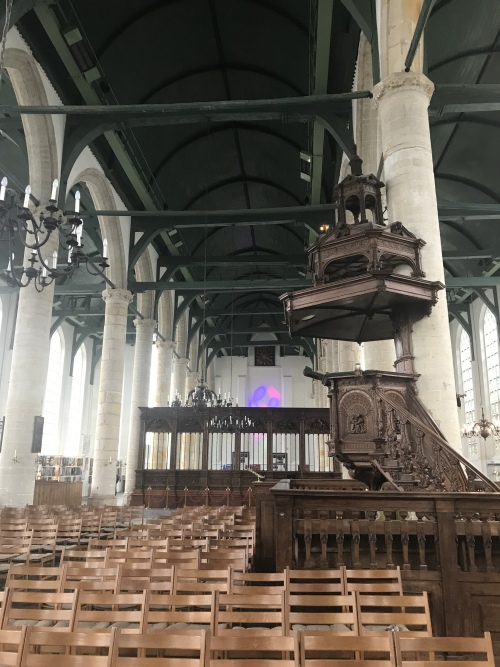 Westerkerk Interior |
To relieve the ennui we set off for a hike into town, passing through back streets we'd never visited before, and should I say never wish to visit again. We inevitably found ourselves walking along Westerstraat. A gallery we passed was open, so naturally I popped inside. Very brightly, coloured pictures adorned the walls, psychedelic furniture was scattered around the room, and oddments were randomly placed on the furniture; not my cup of tea. But I noticed at the back another room, where a group of schoolchildren were busily creating works of art at a table. They were buzzing with chatter.
A lady who had been sitting at the table with the children came through to greet me. "My husband and I are artists. We both paint, and I also make the furniture," she told me. "I see you run a class too," I replied. "Yes, I run a class for groups of children for several weeks. They are very critical of their work, but I always tell them not to be so self-critical. There is no such thing as a bad picture," she said. "Just happy mistakes," I added, and she howled with laughter and agreement.
Further on we discovered there was an art exposition on in the colossal Westerkerk. We entered to explore. The exposition was essentially a collection of local artist's portraits plus a few portrait photos. The standard ranged from good to very bad, but the star attraction was the church itself.
A very helpful chap who spoke excellent English helped us discover the story of the church. The construction of the present church, dedicated to Saint Gommarus, started around the year 1470. It is a so-called 'three-aisled hall church', built in three phases. They worked from east to west. It has become a big church; 30 meters wide, 70 meters long and internally 17 meters high. In the church, whose character has been preserved, we find the following parts worth seeing: the choir screen ( 1547 ), the pulpit ( 1566 ), the organ ( 1549 ), and the library (16th and 17th centuries). The tombstone floor is also still original. The church is on the UNESCO list of the 'top 100' of Dutch monuments.
During the construction of the tower, it was recognised that the ground was too swampy, so the tower had to be built separately. However, funds ran out to pay for bricks, so a wooden tower was built at the front instead. It was subsequently found that the bells were too heavy for the wooden tower, so it was reinforced inside with ships' masts.
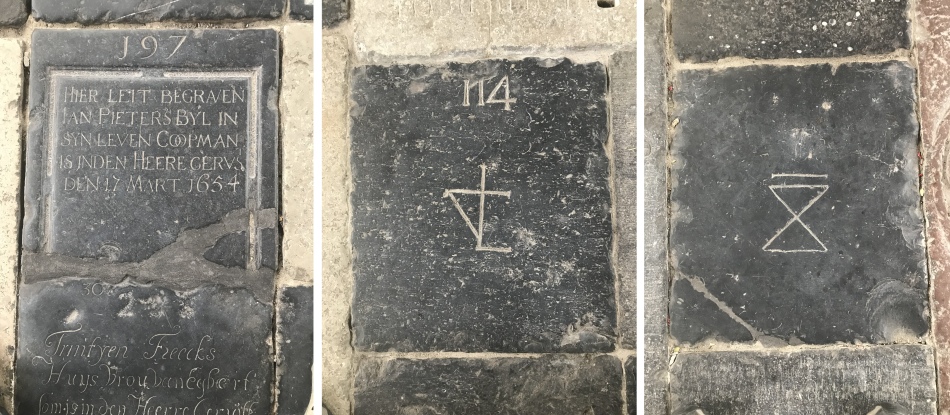 Westerkerk Tombstones |
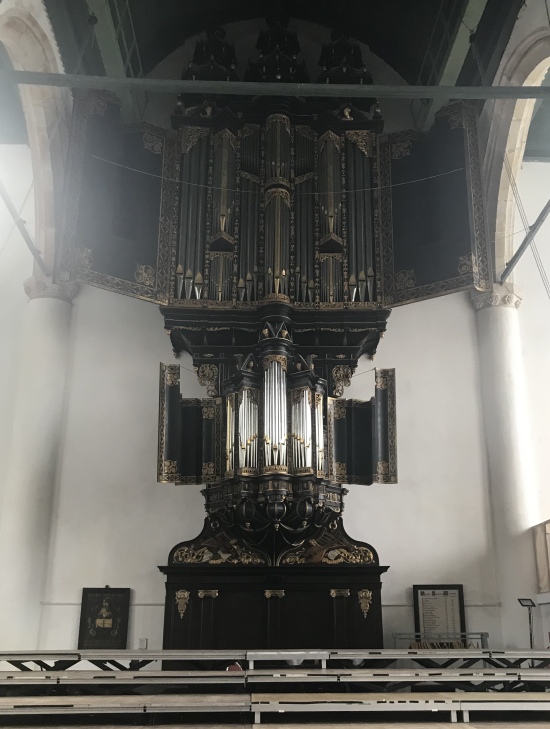 Westerkerk Organ |
In addition to a number, most tombstones have a unique distinguishing mark. These are often so-called 'house brands'. The origin of these marks is not entirely clear. Some find that they correspond to ancient Germanic runes. There are also tombstones with professional symbols such as a trowel (mason), a compass (sailor), or a 'sorrow' pegs (fisherman). There are also many tombstones with inscriptions.
There are still 12 decorated gravestones (with inscriptions) from before the Reformation (1572). The oldest of these is from 1503.
During the occupation by the French (around 1800) the titles and weapon figures had to be cut away. In 1795, burial in churches was banned from above. The last interment took place in 1820.
Recently, Cees Groot mapped out who the owners of the graves were and who are or have been buried for the association Oud Enkhuizen and the Westerkerk. An impressive amount of work. This is about more than 40,000 names!
The organ of this church was built by the famous organ builder Hendrick Niehoff. He finished the work in 1549, The organ case is believed to be the work of Adriaen Schalcken. Originally the organ was used primarily for public performance. In the course of the 17th century, it was also played to enhance the sound of congregational singing. Organ builder Roelof Barentsz Duyschot spent the years 1679-1683 building a new instrument into the existing organ case: 111 front pipes still remain. The last restoration of the main case revealed two sections (at the south side) of the figurative painting that dates back to those years too. In 1838, all the ornamentation disappeared behind the current black layer. The measures that had to be taken for the building of a new pneumatic organ by D. C. Steenkuyl in 1899 weakened the entire construction to such an extent that this instrument could not be reinstalled after the last restoration of the organ case in 20009. The church is currently raising funds to restore the historically valuable case to its former glory.
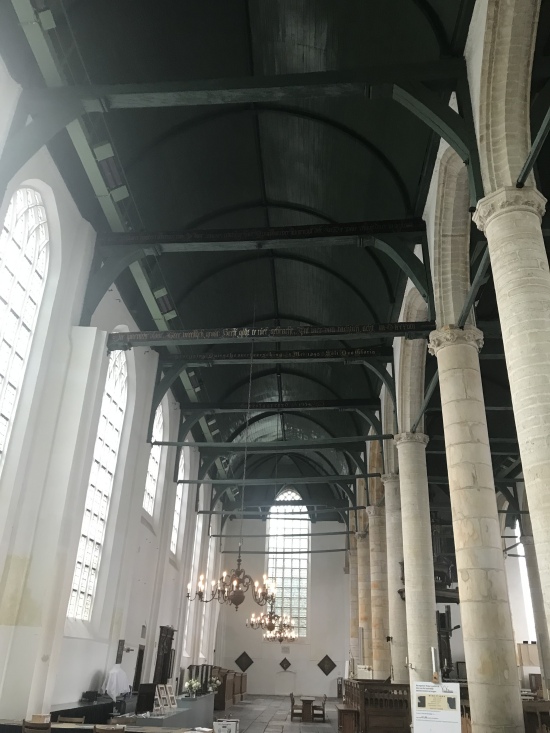 Westerkerk South Aisle with Painted Beams |
In the year 1572 / by Jehovah's mighty hand / the papacy was cast out of this town / the true religion planted therein.
The above text in a golden swash characters across one of the beams bears the triumphant message that the Catholic Saint Gommarus Church became the Protestant Westerkerk in 1572. ' The "papacy" out and with God's help, the "true faith" in'. In 1572 in Enkhuizen and other Dutch towns, rebellious Protestants formed the core of the anti-Spanish resistance. Religious and political struggle went hand-in-hand. Members of the 'new faith' came into power in the town hall. They took possession of the Catholic Church buildings and transformed them for Protestant worship.
The Spanish fleet / terribly large / brought to destruction by God / in the year 1588.
The above rhyme on another beam refers to the notorious demise of the enormous Spanish fleet, the Armada, which in 1588 sailed towards the North Sea in order to attack Protestant England. The Enkhuizer Jan Gerbrandsz was shortly before appointed vice-admiral of Holland and West Friesland. With small ships he blockaded the harbours on the Flemish coast, preventing a Spanish army of 26,000 men from boarding the ships. The invasion of England was a failure. A raging storm caused great damage to the Spanish fleet. In Holland and England it was said that God had sent a 'Protestant wind'.
We sauntered back along the Oude Haven. One of the pubs had expanded out onto the harbour front, with stalls selling pulled pork and drinks. A DJ played an eclectic mixture of music in the background. On the opposite bank a couple of lads were setting up for their gig on the bank. We sat by the harbour enjoying a beer, examining the boats and people watched.
Back at the marina the Russian sailor sought our advice on the lock and bridge at Amsterdam, and the sea lock at Ijmuiden, which we happily supplied. Again we urged him to seek local tidal advice at Ijmuiden for the sail down the coast to Scheveningen.
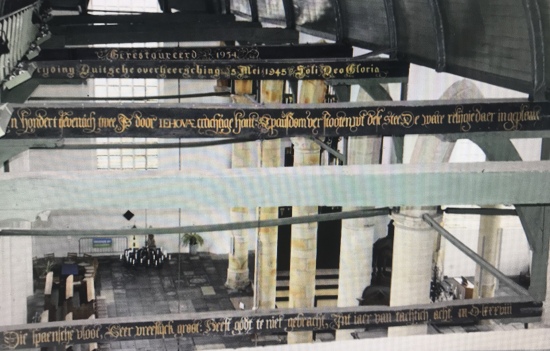 Painted Beams |
Heading back to the boat by the Oude haven, the DJ we had seen earlier was no longer there, but the small stage set up on the opposite bank below the Drommedaris was in full swing. A young fellow was singing his heart out in Dutch, German and English, accompanied by canned music. He was quite good. A group of young women with drinks in their hands sang and danced just below us, and hordes of other folks around us watched the performance, sang, danced and were generally having a good time. It was a lovely evening of entertainment, even Rex was tapping his feet and jostling about ( the nearest thing he does to a dance). And when the chap was singing "Sweet Caroline," we were all singing and bouncing. Happy memories.
